Menus
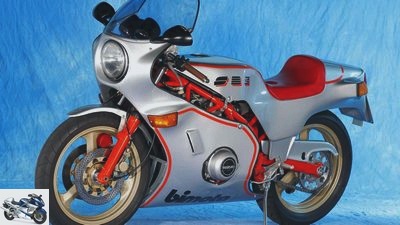
Bilski
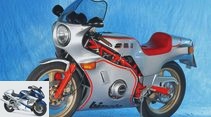
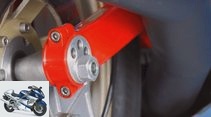
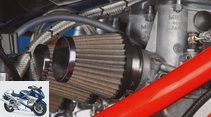
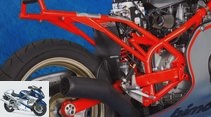
12th photos
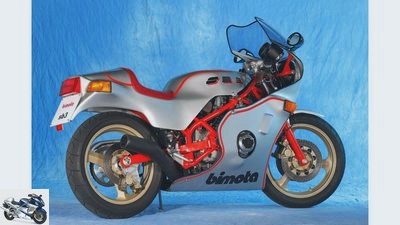
Bilski
1/12
In the studio: The Bimota SB3 that rolled off the line in 1979 as the first copy.
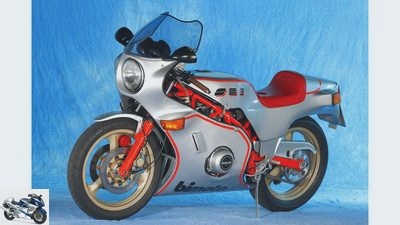
Bilski
2/12
For soloists: The one-piece combination of tank cover and bench seat only provides one place for the driver. Fastened with three screws, it can be folded up or removed quickly and easily. remove. The seat is as hard as it looks.
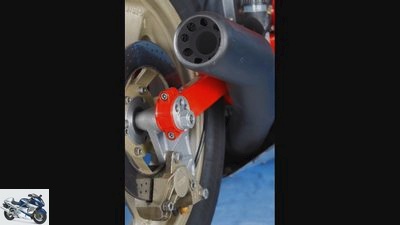
Bilski
3/12
The once black chrome-plated Termignoni four-in-one system nestles tightly around the wide steel swing arm.
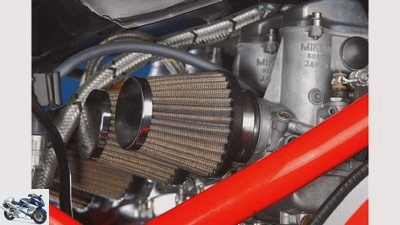
Bilski
4/12
Breathe in deeply: The SB3 snorkels through four almost undamped air filter elements.
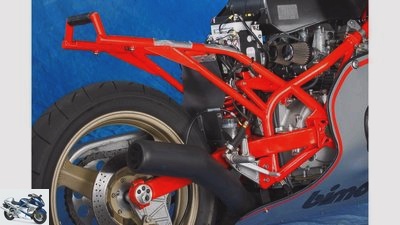
Bilski
5/12
Red for the world: the rear frame only has to withstand the weight of the driver, the battery is high, but easily accessible.

Bilski
6/12
Eccentric chain tensioner on the SB3.
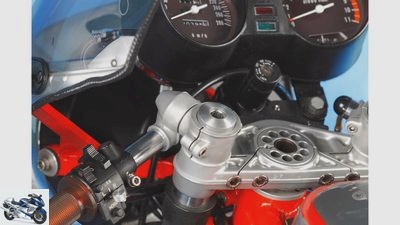
Bilski
7/12
Forged and split triple clamp and adjustable handlebar stubs.
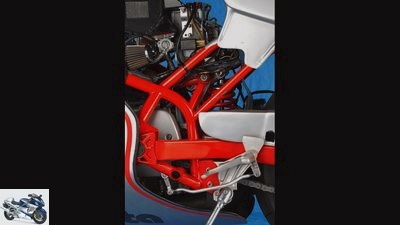
Bilski
8/12
Great specialty: the pivot point on the pinion axis.
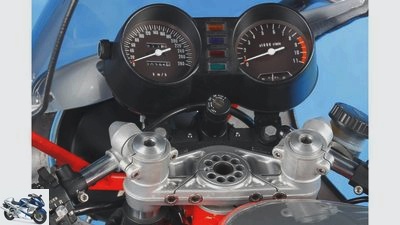
Bilski
9/12
Only in the cockpit does the staid mass-production flair of a Suzuki GS 1000 prevail.
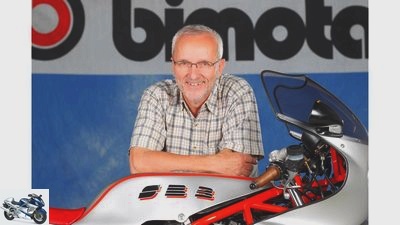
Bilski
10/12
Hans-Jurgen Schmitt knows almost every screw on his SB3 by first name and has amassed numerous Bimota devotional objects.
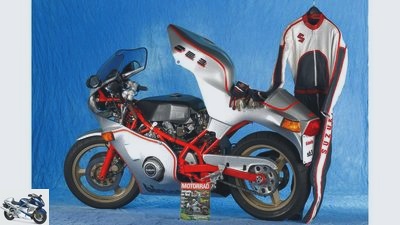
Bilski
11/12
Finely dressed: Bimota SB3 and station wagon in 1979 partner look.
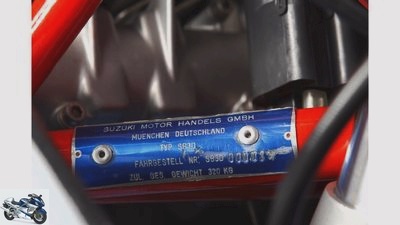
Bilski
12/12
Bimota SB3: copy with chassis number 00001.
Bimota SB3 in the studio
The first example of the Bimota sports car ever built
Content of
A Bimota SB3 is a rarity. Things get particularly exciting when it comes to the first specimen built in 1979 with chassis number 00001. Hans-Jurgen Schmitt discovered the Italian in 2002 and brought it back to life.
B.do not wiggle. In the 1970s, this demand on motorcycle chassis still belonged to the field of vision for the future and was largely science fiction. Dreams of committed riders who want to fully exploit the performance of their production motorcycles without constantly having to struggle with overburdened chassis. This is where the (pre-) story of the silver-red studio guest begins. In 1972, a motorcycle enthusiast who would later become world famous, no longer wanted to accept the chassis qualities of his private Honda CB 750 Four and began to build a more suitable chassis for the series engine. His name: Massimo Tamburini, later creator and co-responsible for such ingeniously designed machines as Ducati 916 or MV Agusta F4. The result was the HB1, H for Honda engine, B for Bimota. The company had existed as a specialist in heating and ventilation systems since 1965. Founded by the three gentlemen Valerio Bianchi, Giuseppe Morri and Massimo Tamburini, from whose last name the company abbreviation Bi-Mo-Ta was derived. In 1973 the company’s new two-wheeler engagement was officially announced, and after various races of the HB1 the two-wheeled Italians built ten of them in series from 1975 onwards. The two-stroke racer SB1 was followed by the second street-legal Bimota, the SB2 (with the Suzuki GS 750 engine), then the legendary KB1 and finally the SB3 in 1979.
For the first test in MOTORRAD, a machine approved for the then extremely active Bimota dealer and importer Reinhold Kraft was available, which had the chassis number 00001 and was identified in the papers as a “test vehicle”. This is exactly the machine that Hans-Jurgen Schmitt, a secret Bimota fan since his youth, discovered ten years ago more by chance while rummaging through relevant sales advertisements. “As early as the late 70s and early 80s, I was often hanging around the Kawa dealer Holy in nearby Schriesheim. At that time, of course, he mainly had the KB models standing around, but the Bimota machines fascinated me from the start. “
Bilski
Bimota SB3: copy with chassis number 00001.
In 2002, finally, the childhood dream was to come true. After initial hesitation, because the SB3 had obviously been neglected in recent years. Schmitt’s wife provided discreet decision-making assistance: “You always wanted a Bimota – now buy it.” The mechanical engineer based on Bergstrasse struck and then made nails with heads in terms of reconditioning (both the motorcycle and the previous history). The SB3 was registered for the Kraft company until June 1992, was registered by the next owner in Speyer in the same month and said ten years later by Schmitt “saved”. “The cladding and the monocoque were repainted, so the entire decor was missing. The engine did not rev up properly, the tires and brake pads were hard, the electrics and some other little things needed attention, ”reports Schmitt. While getting various information and reading about the SB3, he came across the test of “his” number 00001 in MOTORRAD, in which the standard Speed-Line magnesium rims were critically assessed. So other, trustworthy rims were needed. But initially the priorities were different: The poor engine running turned out to be a (Mikuni-typical) carburetor problem. One of the idle air adjustment screws had the tip broken off and stuck in the nozzle. Thanks to the well-equipped workshop in the basement, the shrewd screwdriver was able to fix the problem himself with great sensitivity.
The engine itself, a production four-cylinder from the sportier GS 1000 S (with 28 instead of 26 carburettors) remained untouched. “It delivered even, good compression and sounded very healthy. So why open it? ”Instead, the avowed pedant preferred to tackle the many other parts that were not in the desired condition. So he dismantled the two-part tubular space frame, weighing just nine kilograms, a true work of art made of a total of 25 straight or precisely bent and neatly welded tubes. Twelve of them form the front main frame, which encloses the engine as a load-bearing part. The rear frame consists of 13 tubes and carries the wide swing arm made of square tubes. All parts were powder-coated in the original color, and the four-in-one system, which is very discreet in its dimensions, was painted black.
Bilski
Hans-Jurgen Schmitt knows almost every screw on his SB3 by first name and has amassed numerous Bimota devotional objects.
Brake discs and pads had also suffered due to the long service life, the Brembo calipers enjoyed an overhaul and have since shone in a newly applied golden paint. Speaking of paint: the trim parts were still in flawless silver, but the original stickers were still missing. The Bimota fan sent a written request to the former importer Kraft and at the same time set about recreating the bizarre SB3 logo on the PC. Many weeks later a package actually arrived at Schmitt, who was no longer expecting it. Sender: Reinhold Kraft. Contents: an original decoration set for the SB3. Bimota man Kraft still helps today when he can. The original version, which is certainly no longer optimally adhesive, was scanned, made from adhesive film and has been emblazoned on the silver Italian since then.
Bilski
Great specialty: the pivot point on the pinion axis.
The freshly fostered 1000 was now, two years after the purchase, ready for its first appearances at classic get-togethers, even won prizes and was at least good for the first little rides. The fragile magnesium rims stood in the way of longer tours or even use in racing training. The hope that the used PVM three-spoke alloy wheels of a GS 1000 S could at least partially fit, quickly burst. Axle diameter, mounts for brake disc or chainring, speedometer drive – nothing fitted, instead required the entire handicraft skills of the screwdriver, who now turned and milled as much as possible. Original paint was not available, so Schmitt painted the wheels in the shade that came closest to the Campagnolos. Revitalized in this way, the SB3 cuts a fine figure today, whether at a standstill or on the race track. Of course, there is no studio photo session with a Bimota without a sound check: In the adjacent underground car park, the sound of the air-cooled thousand meter with the generously open Termignoni four-in-one system comes into its own. The Suzuki four-wheeler grumbles to itself, screaming loudly with short thrusts of the gas, but by no means chubby. The bassy, snotty sound promises far more than the specified 90 hp. Whereby Schmitt knows how to talk modestly about racing training courses, during which he was asked by astonished drivers about the performance of the Italian exotic, because they could hardly keep up with the SB3 on the straights with their 130 hp bikes.
But the 56-year-old is less and less likely to take such trips to the slopes, where a Bimota always feels particularly comfortable and where it still proves to be a stable racing device today. The proud SB3 owner rarely finds the time to chase his number one through the nearby Odenwald. Real racing pace is hardly possible here, because of the ultra-hard chassis setup, which reveals every bit of bumps on the winding country roads and rags the line in no time at all. But Schmitt already enjoys owning it, looking at it in the garage and knowing: Number one is alive.
Technical specifications
Bilski
Red for the world: the rear frame only has to withstand the weight of the driver, the battery is high but easily accessible.
Engine:
Air-cooled four-cylinder four-stroke engine, two valves each, operated by two overhead camshafts and bucket tappets, bore 70 mm, stroke 64.8 mm, displacement 997 cm³, 90 HP at 9000 / min, Mikuni round slide carburetor, Ø 28 mm, wet sump lubrication, Multi-disc oil bath clutch, five-speed gearbox, chain drive
Landing gear:
Two-part tubular space frame, telescopic fork at the front, two-arm swing arm at the rear, double disc brake at the front, disc brake at the rear, tires 3.50 V 18 at the front, 130/80 V 18 at the rear, weight: 210 kg, tank capacity 15 liters
Related articles
-
Driving report Bimota SB 6 R Draft horse Often promised – never kept. Only the SB 6 R has what the SB 6 was previously lacking: power and performance. The thing …
-
Comparison of Bimota YB 11 Nuda and MV Agusta Lustale
Comparison of Bimota YB 11 Nuda and MV Agusta Lustale strip community When two divas of the two-wheeled upper class share their …
-
Impression Bimota SB 3 The Bimota by Klaus P. A Bimota from the very beginning is not a motorcycle, it is an event. Such a sparkling synthesis of …
-
On the move with Majestic 350 from 1930 and Bimota Tesi 1D-SR from 1992
41 photos r-photography.info 1/41 Picture gallery: Majestic 350 from 1930, Bimota Tesi 1D / SR from 1992. r-photography.info 2/41…
-
Bimota DB9 Brivido S in the test
Jahn 18th photos Jahn 1/18 You take a powerful engine, tune it according to your own ideas and put it in a self-developed, sporty chassis – the result is…
-
Short test Bimota SB 6 R Bella Bestia In the pilot series, the devil was in the details. Importer Konemann promised a remedy. Does the beautiful predator work …
-
Driving report Bimota DB5 1000
Jahn driving report Bimota DB5 1000 Why not? The idea is simple, the implementation fascinating. With an air-cooled two-valve in a tight corset …
-
Technology highlights: Bimota Tesi, Honda NR 750, Norton TT
Jahn Technology highlights: Bimota Tesi, Honda NR 750, Norton TT Techno motorcycle The pace of further development in two-wheelers is getting faster and…
-
Robbiano design Report: Bimota DB5 And there was form The creative process at Bimota did not go as fast as in the Bible. But at least the new DB5 got its…
-
Bimota HB4 Limited Edition Moto2
Limited Edition Moto2 Bimota HB4 Beautiful racing motorcycle from Bimota Content of In keeping with the tradition of the luxury forge from…